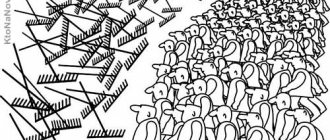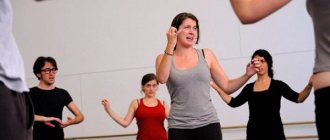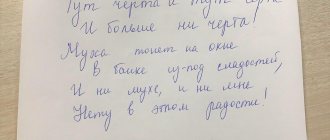Laser vision correction is a surgical procedure aimed at correcting refractive errors. Experts include myopia (nearsightedness), hypermetropia (farsightedness) and astigmatism as refractive errors. Laser vision correction is a real chance to get rid of the need to use external optical correction - glasses and contact lenses, which are necessary for the above anomalies.
The goal of all existing methods of laser vision correction is to ensure that light rays passing through the eye are able to focus on the surface of the retina, and not before it, as in myopia, and not behind it, as in hypermetropia. This is achieved by changing the shape of the cornea with a laser beam, thus correcting its refractive power (refraction).
The refractive power of the human cornea is, on average, ±43 diopters (D). This is almost 80% of the entire optical power of the eye, which is approximately 58-60D. That is, by surgically modeling the curvature of the cornea, ophthalmologists correct refractive errors.
From the history of laser correction
The idea of correcting refractive errors by changing the shape of the cornea, which became the basis for laser vision correction, belongs to the Japanese ophthalmologist Sato. He tried to implement it in 1939, performing a series of operations on the eyes with non-penetrating incisions along the edge of the cornea. In 1949, José Barracuer, a Colombian ophthalmic surgeon, proposed using a laser beam in this operation. Our famous compatriot, academician S. N. Fedorov, completely improved the technique in 1972. And a little later, in 1976, the first excimer lasers appeared, produced by the IBM Corporation.
The first laser vision correction operation was performed in 1985. It was carried out in Berlin, and since 1988, excimer laser vision correction has been widely practiced in the USA, European countries and Russia.
Today, laser vision correction operations are performed by ophthalmologists in 53 countries. Equipment for operations is constantly being improved, and methods of surgical intervention are changing. The following methods of laser vision correction are recognized as the most popular and effective: photorefractive keratectomy PRK (PRK), LASIK (LASIK), Femto LASIK (Femo LASIK) and SMILE.
LASIK/Femto LASIK
LASIK, or laser keratomileusis, is a more modern version of laser vision correction than PRK, which is performed in 2 stages. The first stage is the formation of a corneal flap (flap) from the epithelial layer, for which a special device is used - a microkeratome. The flap is then pulled back to make way for the laser beam.
At the second stage, direct remodeling of the corneal stroma is carried out using ablation (evaporation of tissue) using an excimer laser. After which the corneal flap is placed in its bed.
FemtoLASIK is a modification of the first stage of LASIK surgery. Namely, to form a flap at the first stage, a femtosecond laser is used here; at the second stage, ablation of the corneal stroma is performed with an excimer laser. LASIK and Femto LASIK are the most widely practiced methods of laser vision correction today.
ReLEx SMILE
The ReLEx SMILE method or refractive lenticule removal through a small incision is a new generation of laser vision correction technologies. To implement it, innovative developments of femtosecond lasers are used, such as VisuMax from the company Carl Zeiss.
The active introduction of femtosecond technologies into refractive surgery has made it possible to develop completely new safe techniques for laser vision correction. Thus, in 2006, German scientists under the leadership of professors V. Secundo and M. Bloom presented the unique ReLEx technique. The first method they introduced was called ReLEx FLEx and consisted of removing the refractive error-correcting lenticule, an optical lens, through a corneal flap made with a femtosecond laser. The second, improved method is called ReLEx SMILE. Its purpose is to remove the formed optical lens through a small incision along the periphery of the cornea.
The main difference between SMILE and other laser correction options is the ability to correct refractive errors without forming a corneal flap and without the risk of displacing the surface epithelium of the cornea.
Thanks to the introduction of ReLEx SMILE, laser vision correction surgery has become a one-stage procedure, which has significantly reduced the number of potential complications. Now, using only a femtosecond laser (without an excimer laser, which is necessary with other methods), a precisely calculated optical lenticule (lens) is formed in the internal media of the cornea, a small corneal incision is made with the help of it, which does not interfere with vision in the future, and the lenticule is removed through it.
Methods of psychological personality correction
COMPETENCIES OF A PSYCHOLOGIST
Know
Psychocorrection methods when using various personality theories in work. Have a sufficient supply of knowledge and skills to carry out corrective measures.
Be able to
Plan personal growth; provide a solution to the problem of professional growth; navigate correctional psychotechnics. Use techniques, methods and means of psychological correction.
Own
Variable methods of psychological correction; methods of individual and group psychocorrection.
BASIC CONCEPTS:
Methods and techniques of psychological correction Methods of body-oriented psychotherapy
A method is understood as a way of organizing activities aimed at achieving a specific goal. Methods are a set of principles, techniques and means used by a psychologist when carrying out correctional work. The method determines the general principle of activity, the methodology is the specific embodiment of this principle in the form of specific procedures and psychotechniques related to a specific method of psychological work based on specific methodological material.
Personal behavior is determined by two functional interrelated aspects: regulatory and incentive. Regulation of behavior is carried out through various mental manifestations, such as sensations and perceptions, attention, thinking, memory, speech, emotions, etc. This ensures flexibility and stability of behavior in various conditions. However, the behavior did not arise on its own, but due to some reasons, motivations for it. The description of the mechanisms of activity and direction of behavior is traditionally associated with the concept of motivation. More broadly, it is understood as the entire set of factors that cause the activity of the body and determine the direction of human behavior. This includes such entities as needs, motives, intentions, goals, interests, aspirations. The most important of all motivational concepts are the concepts of “need,” “motive,” and “goal.”
Needs, motives and goals are the main components of a person’s motivational sphere.
Each of the needs can be realized in many motives, and each motive can be satisfied by a different set of goals. The direction of psychological correction includes the motivational-need sphere of the individual. Personality
is a psychological new formation that is formed in the life relationships of an individual as a result of the transformation of his activities.
Need
is a reflection in the form of experiencing the individual’s need to support the body and develop the individual.
In humans, need as a state of personality is always associated with a feeling of dissatisfaction, which guides current behavior. Motive is
an impulse to commit a behavioral act, generated by a system of human needs with varying degrees of awareness or unconsciousness. With the same need, a person’s motives can be a variety of objects. Hence the concept of “motive”, as a stable personal property, which, as if from within, encourages a person to perform certain actions in order to acquire the desired item of need. People as individuals differ from each other in their diversity and special combinations of needs, which in humans manifest themselves in a variety of motives. Most of them are conscious, but there are also unconscious motives - attitudes and drives. Consciousness, as the highest level of a person’s reflection of reality, is a personal formation that allows a person to separate the subjective picture of the objective world that opens to him from this world itself and feel it as a part of himself. One of the components of consciousness is the special activity of goal setting, which is significant for corrective work with a person in order to form his social ideas. Conscious experiences may have certain difficulties in interpersonal relationships, in choosing a profession, and so on.
Consciousness has a rather complex structure - existential (biodynamic properties and sensory images); reflective (meaning and meaning). The function of consciousness is to formulate the goals of activity in the preliminary mental construction of actions and the anticipation of their results, which ensures the regulation of human behavior and activity. The object of reflection can be a reflection of the world, thinking about it, and ways for a person to regulate his behavior. Emotions are associated with volitional behavior, containing a subjective assessment of the significance of life events for a person, in the form of experience. A personality has its own unique emotional make-up.
Personality correction methods
determined by goals and psychotechnical techniques. A significant goal of personal growth is to restore a better level of functioning of the individual in activities, in interaction with people, taking into account all the abilities of the individual, his capabilities and limitations (related to the disease) and life circumstances. Personality correction methods are intended for any healthy age category, but with various problems: problems of low self-esteem, lack of self-confidence, weak will, etc.
The purpose of personality correction is
maintaining or restoring the optimal level of personality manifestations in society (interaction, communication, behavior, etc.). At the same time, a person is able to observe feelings without reacting to them in actions, and use an understanding of one or another method of personal growth.
Duration of correctional classes.
The use of personality correction methods can last from several days to several years.
Psychotechnicians.
Working with defense mechanisms and conflicts with the help of a psychologist or psychotherapist. Discovering alternative possibilities. Assessment of types of behavior that pose a threat to life and health, organic causes of the disease.
Psychotechnics in classical psychoanalysis includes 5 basic techniques: a) the method of free associations, b) dream interpretation, c) interpretation, d) resistance analysis, e) transference analysis.
For example, the free association method involves the generation of involuntary statements that come to mind in a random order, the content of which can reflect any of the client’s experiences. While sitting or lying down, often with eyes closed, the client simply says whatever comes to mind, carefully guided by short statements or remarks from the therapist.
Answers to the psychologist’s questions, freedom to reject the psychologist’s (psychotherapist’s) interpretations. Exploring your fears as you begin personal growth. Explanation of your “passive” behavior. Awareness of your disappointments in working on yourself. Learn to appreciate the safety atmosphere. Learn to work with dreams. Understand your personal reactions in any life situations.
The structure of personality correction includes such components as self-knowledge; self-motivation; self-regulation; self-realization.
A method is a path, a way to achieve the goal of correction. The technique is a means of achieving the goal of correction. Each method of personality correction involves numerous techniques.
The difference between SMILE and PRK and LASIK
Operations using PRK and LASIK methods are performed with displacement of the surface epithelium of the cornea and modeling (ablation) of the required shape of the cornea in its deep layers using an excimer laser. However, when performing vision correction using the PRK method, patients experience significant pain during the first two days after the intervention, and the rehabilitation period until complete recovery and stabilization of vision lasts at least two months. Whereas when correction is performed using the SMILE technique, complete recovery and maximum visual acuity are possible already on the second day after surgery.
Collective psychocorrectional work
Work under the PTGH program is carried out with groups of patients of 5-10 people. It is mandatory to include both male and female persons in the group. The main course of RTSN is designed for 12 - 15 lessons. Group classes are led by a specially trained psychologist and psychiatrist.
It is advisable to organize psychological correction groups at three levels of the rehabilitation process:
1. A group of patients in a psychiatric hospital consists of 4 - 8 people. Classes are held 2 - 3 times a week for G.5 - 2 hours. The program is designed for 10 - 12 lessons. Each time the group is formed completely anew.
2. Groups of day hospital patients consist of 10 - 12 people. Classes are held 1-2 times a week. Classes can be structured according to a “end-to-end” scheme: the patient is included in a permanent group and is removed from it upon discharge.
3. Outpatient advisory groups, classes are held once a week, the number of members and composition of the group may change.
Rehabilitation training for social skills consists of three stages. At the first stage, the training is aimed at relieving “communicative tension” and changing the overvalued attitude towards communication. At the second stage, the main thing is the training of social-perceptual skills and other underdeveloped social skills. The third stage is aimed at training in the implementation of the chosen strategy of social behavior and maintaining a social role. During the training, patients expand the range of perceived and their own interpersonal interactions and increase their social competence.
Before conducting the RTSN course, the psychologist or psychiatrist leading the group draws up an approximate group lesson plan in accordance with specific patients and the main tasks facing the group, which indicates the time and place of the classes, the number of participants and an approximate work plan for each lesson. The work plan is recorded in the group diary, a document maintained and signed by the leading groups. The group diary also contains a list and brief clinical and pathopsychological characteristics of the patients included in the group, as well as individual psychocorrectional tasks for each of them. Immediately before the lesson, a detailed lesson plan is drawn up indicating specific exercises (main and reserve). After each lesson, the facilitator’s report on the lesson, the characteristics of the behavior of its participants, and the dynamics of their states is entered in the diary. The diary also records changes in the composition of the group and other observations and comments important for psychocorrectional work. At the end of the RTSN cycle, the facilitator records in the diary data on changes in the behavior of the participants, an overall assessment of the effectiveness of the work, and data from a repeated psychological examination of the group members. The group diary is the main form of reporting on this type of psychocorrectional work and provides valuable material for the leader to improve work efficiency.
Each lesson in the RTSN course lasts 1.5 - 2 hours and can be divided into three parts. The first part of the lesson is an introductory exercise, which is aimed at relieving the tension of the participants, eliminating communication anxiety, and activating the gaming component of the behavioral attitudes of group members. Exercises using motor, pantomimic and, to a lesser extent, verbal means are most often used. The first exercise in the lesson is carried out without analysis and without extensive discussion.
The second, main part of the lesson is the central exercises that carry the main psychocorrectional load. They are developed specifically for each group and their content varies significantly from lesson to lesson, in contrast to the exercises of the 1st part of the lesson.
For example, at the first stage, such an exercise could be an “interview” in which all group members take turns asking each of its members, including the presenters, any questions concerning the interviewee personally, who in turn can give any answers to them. The purpose of the exercise is to enhance the acquaintance of group members, relieve tension in the face of “tricky” questions (after all, the answer can be any!), increase the interpersonal activity of group members, and practice conducting a conversation in question-answer mode. At the second stage of the group’s work, the central exercises are aimed at training individual skills, primarily the skills of perceiving and expressing emotions, non-verbal communication. Such exercises include: “transferring emotions”, “talking through glass”, etc. The third stage of the group’s work is reflected in changing the content of the main exercises towards practicing holistic behavior, that is, playing out various life situations and resolving them when implementing different behavioral strategies participants. In the main part of the lesson, several plots can be analyzed during one lesson - this depends on the pace of the group’s work.
The third, final part of each lesson is structured in such a way as to consolidate the relief of communicative tension achieved in the group, increase the cohesion of the group, and increase the motivation of the participants before the next lesson. Here you should use exercises with a minor verbal component, performed collectively and containing elements of relaxation training. Such exercises include, for example, “sculptural composition”, “putanka”, “wax stick”, etc.
At the end of the course of RTSN classes, patients should be re-tested using the same methods that were used during their psychological examination and, by comparing the results, evaluate their changes and the overall effectiveness of the work done. This information should be conveyed to group members, since positive changes strengthen the patient’s belief in the possibility of a full recovery and increase their willingness to cooperate with other people.
If, after completing the main part of RTSN, patients experience significant positive changes, but the number of classes is not enough to consolidate the results obtained, the patient should be recommended to attend support classes in a group at a day hospital or outpatient group upon discharge from the hospital. The program of these classes is drawn up immediately before the class in accordance with the current problems of the patients who are currently part of the group. The main tasks of RTSN support groups are to consolidate the results obtained and the most complete transfer of what has been achieved to the real life of patients. After completing a cycle of classes, participants acquire a stable and active orientation in the socially effective and acceptable boundaries (limits) of resolving various types of social situations.
Individual psychocorrection work
The difference between organizing group psychocorrectional classes with patients with endogenous mental disorders of adolescence lies, in particular, in the fact that they are necessarily supported by painstaking individual work carried out in parallel at all stages of collective RTSN.
Individual psychocorrectional work, immediately preceding inclusion in group RTSN classes, contributes to the formation in patients of a stable positive attitude towards the system of social rehabilitation measures and increasing the level of psychological readiness for active participation in psychocorrectional work. It is aimed both at overcoming the resistance (active or passive) that many patients have and mistrust of this type of help, and at developing a constructive, balanced and realistic attitude towards its capabilities and tasks. In the process of searching, carried out jointly with a psychologist, the patient “objectifies” the main problems of the current life situation, carries out the initial stage of assessing the adequacy of his basic psycho-age ideas and expectations, the constructiveness of the system of self-esteem, “Self-concept”, “Self-image”. The desire to increase one’s personal and general social competence and the effectiveness of social functioning is activated and formed. A basic outline of the means and ways of implementing these tasks is emerging. In particular, there is a perceived need to establish more meaningful interactions with socially competent people.
Subsequently, after including the patient in the cycle of regular collective classes of RTSN, the goal of individual psychocorrection work is to clarify the objectives of these group classes, stimulate the patient’s purposeful activity, as well as search for and identify factors that create the most favorable conditions for his more effective learning in the group. In addition, here the patient is helped in finding his own line of behavior when interacting with other members of the group. There is a constant promotion and clarification of the patient’s main individual goals, which can be realized at this stage of group classes. Discussion with the patient of what is happening in the group, his findings, successes and failures leads to the fact that his experience of personal interactions in the group is better understood, and he quickly forms realistic demands for himself and others. Often, for the first time, experience is gained in finding a reasonable compromise with people who express opposing points of view and have different life values.
The combination of individual and group forms of psychocorrectional influences contributes to the timely implementation in practical activities of the patient’s zone of personal capabilities, expanding in the process of therapy and psychological classes, and also optimizes the processes of assimilation and active use in everyday life of knowledge and skills acquired in the group.
A special task of individual psychocorrectional work is to provide emergency, crisis support in cases of increasing mental tension, as well as in the manifestation of suicidal thoughts and tendencies. For this purpose, intensive emotional support is provided, techniques are used that allow them to quickly block and deactualize them, as well as changing some parameters of perception and the system of self-esteem. To consolidate the achieved positive effect and to prevent similar conditions in the future, it is recommended during this period to organize individual and group classes so that they lead to the patients’ actualization of their positive, constructive experience of overcoming acute situations. The search for personally significant anti-suicidal factors, the formation of a simple and specific set of internal self-regulation acceptable for a given patient, are combined with the expansion of his knowledge about external, social supports and means that can be used by him in crisis situations (calling his doctor, psychologist or “helpline”, etc.).
After completing group classes, one or two individual psychocorrectional conversations are required to orient the patient to use the acquired knowledge and skills in practical activities. The successes achieved by him in the process of group search are emphasized, and positive motivation for various types of psychological support is reinforced. It is the combination of individual (dialogue, concrete) and group (flexible) (for each of his social skills) features of social adaptability that most distinguish him from his peers.
3. The compensation coefficient for the “social deficit” is determined by the following formula:
K - self-assessment of each skill, Ks - peer's assessment of each skill, T - number of skills assessed.
4. The coefficient of difference between the subject and his peers in terms of the level of development of social skills is determined by the following formula:
The difference between SMILE and LASIK and Femto LASIK
Carrying out two-stage LASIK and Femto LASIK procedures requires the formation of a certain flap on the surface of the cornea (flap) with further modeling of the corneal stroma with an excimer laser (ablation). When performing vision correction using the SMILE method, only the VisuMax femtosecond laser is used, in one step forming both an optical lenticule in the corneal stroma and a small incision along the periphery of the cornea to remove it. This ensures greater safety of surgical intervention and a reduction in rehabilitation time.
Comparison table of laser correction methods
| PRK | LASIK/Femto LASIK | ReLEx SMILE | |
| Ablation type | Subepithelial | Stromal | Lenticule extraction |
| Laser system | Excimer laser | Excimer laser/Excimer and femtosecond laser | Femtosecond laser VisuMax |
| Recovery period | 1-2 months | 5-7 days | 1-2 days |
| Negative consequences | Pain syndrome, possible complications | Possible complications | Complications are rare, there are no complications of Flap surgery |
Features and advantages of the SMILE method
The SMILE laser vision correction technique differs significantly from all previously practiced ophthalmic technologies for the surgical correction of refractive errors. Among its obvious advantages are:
- No superficial corneal flap (flap ). This guarantees minimal risk or complete absence of serious complications of flap surgery - hays and keratoectasia.
- Ultra-small corneal incision (up to 4 mm). Despite the fact that Lasik and Femto-Lasik methods require a corneal incision, the size of which is up to 20 mm, which is almost 80% larger.
- Biomechanical stability of the cornea . Laser vision correction operations using the SMILE technique practically do not affect the upper layers of the cornea, leaving them absolutely biomechanically intact. In the case of the Lasik technique, on the contrary, due to ablation of the corneal stroma, its biomechanical strength is seriously reduced, which creates a risk of developing keratoectasia.
- Low risk of dry eye syndrome. A small incision along the periphery of the cornea during surgery using the SMILE technique, instead of forming a corneal flap, causes less trauma to the nerve endings present in the cornea. According to research, this is the main factor in the lower incidence of dry eye syndrome in patients undergoing vision correction with the SMILE technique.
- High precision of manipulations performed by the surgeon . Femtosecond laser technologies of the SMILE technique are provided by a unique laser from the company Carl Zeiss VisuMax, which is capable of sending laser radiation in very short compressed pulses, which makes it possible to achieve a high level of energy density and guarantees high precision of the surgeon’s manipulations.
Laser correction methods: how to choose
Laser vision correction has existed since the 80s of the 20th century. During this time, a fairly large number of methods for carrying out such an operation have appeared. How do they differ and how to choose the right one? We addressed these questions to the leading ophthalmic surgeon of the ophthalmological network, Oleg Anatolyevich Volkov.
Oleg Anatolyevich, what methods of laser vision correction exist?
The average and most famous method is LASIK. A more modern method with modification is FemtoLASIK. If the cornea is thick enough, we do LASIK or an improved version - FemtoLASIK, which we sometimes insist on if the cornea is not thick enough for mechanical cutting. If the thickness is not enough even for FemtoLASIK, then we do PRK (photorefractive keratectomy). Sometimes PRK is performed for some professional indications, for example, this method is suitable for the military, rescuers, and athletes.
What is the difference between LASIK and PRK?
The fundamental difference between the methods is that with any LASIK there is a suction cup and a keratome: either laser or mechanical. The keratome cuts off part of the thickness and the lens is ground into the thickness of the cornea.
In PRK, the surface layer (epithelium) is removed and correction is made from the surface without using the thickness of the cornea for cutting.
The disadvantage of PRK is that it takes longer to heal, it hurts longer, and there are some unpredictability. Therefore, we try to avoid PRK, but, nevertheless, sometimes we have to do it.
Patients who have undergone PRK must be prepared to wear sunglasses for quite a long time, about four months, and be observed for a longer period of time. With high degrees of myopia, there may be clouding of the cornea and increased eye pressure due to steroid eye drops.
FemtoLASIK uses a disposable interface consisting of a suction cup and a cone that interfaces the laser and flattens the cornea for optical cutting. This allows you to get better cut quality.
What is the difference between LASIK and FemtoLASIK?
FemtoLASIK uses a disposable interface that consists of a suction cup and a cone, the latter interfaces with the laser and flattens the cornea for optical cutting. The sensations are the same as with LASIK, although the operation itself takes a little longer. But the quality of the cut and safety are not comparable to mechanical ones, because there the laser controls everything, and no factors will affect the quality of the flap.
At what indicators can laser correction be performed?
In principle, it is possible to remove –15 diopters with astigmatism. The plus side is more complicated - farsightedness due to biometric factors is removed worse and the effect is unstable. The instructions for the laser say that you can remove +6 diopters, but in fact +3–4 diopters. This is all very individual - with a steep cornea, it may be possible to achieve plus six, but with a flat cornea, only plus two is possible. The same applies to astigmatism - we can remove quite large degrees, understanding that there is such a thing as additional correction. The likelihood of additional correction for large astigmatisms, as well as for large minuses, is always present. For greater accuracy of the operation, in some cases we use modifications such as Custom LASIK - a personalized wavefront laser. This operation is more complicated and more expensive - it requires special equipment.
Myopia can be corrected down to –15 diopters. Farsightedness is more difficult to remove, and the effect may be unstable.
How does Custom LASIK work?
There is such a device - a wavefront analyzer. He sends a flat wave front to the fundus of the eye, looks at the reflection - based on this, together with the doctor’s corrections, he calculates what needs to be done so that the highest quality image is on the fundus. At the same time, it takes into account such a moment as cyclotorsion (rotation of the eyeball). With astigmatism, this affects visual acuity.
Can the patient choose the method of correction himself?
With a normal cornea, the patient can choose the method himself. If the cornea is too thin, then the choice is either PRK or FemtoLASIK. I recently had a case where Femto was needed according to indications, but for economic reasons the patient chose PRK. I'm sure he'll regret it, but in a couple of weeks he'll forget and everything will be fine.
What advice can you give to our patients and readers? For those who have not yet decided on laser vision correction.
Doubt, read, think. Make your own decision.
The doctor can only give advice. But the decision and responsibility for this decision always lies with the patient. If a patient studies information about laser correction, he can ask more precise questions, evaluate the answers more competently, and based on this it will be easier for him to make his decision.
Thank you, Oleg Anatolyevich, for the conversation.









